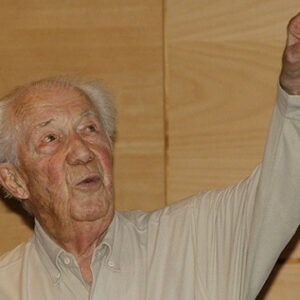Christian de Duve was a Belgian cytologist and biochemist who was well-known for his studies about the inner workings of cells. In 1974, he was awarded a part of the Nobel Prize in Physiology or Medicine for his discovery of the peroxisome and lysosome. His discoveries were essential in elucidating the biology of various hereditary disorders. Born to Belgian refugees in Britain during World War I, he and his family returned to Belgium when he was a baby. As a child, he was more interested in literary fields than scientific ones. His interests altered as he matured, and he chose to study medicine at the Catholic University of Leuven. As a medical student, he also conducted research in Professor J. P. Bouckaert’s physiology laboratory. Over time, he became increasingly interested in research, and by the time he received his MD, he had abandoned the notion of practicing medicine. Instead, he pursued a profession in academia that provided numerous opportunities for research. Christian de Duve was an expert in subcellular biochemistry and cell biology, and he discovered novel cellular organelles. Together with a colleague, he validated the location of the hydrolytic enzymes (acid hydrolases) of lysosomes. His study on cell fractionation provided insight into the function of cellular structures.
Childhood & Adolescence
Christian René Marie Joseph de Duve was born in Great Britain on 2 October 1917 to Belgian refugees Alphonse de Duve and Madeleine Pungs, who had fled the conflict. His father was a merchant. The family returned to Belgium in 1920, following the end of the war.
He matured into a bright and inquisitive student who excelled in his academics. As a child, he was more interested in literary subjects than in scientific ones. Despite this, he chose to pursue medicine due to its promising employment prospects.
In 1934, he enrolled at the Catholic University of Leuven with the intent of specializing in endocrinology. As a medical student, he joined the physiologist Joseph P. Bouckaert’s laboratory.
In 1940, when Germany invaded Belgium, de Duve joined the military to participate in World War II. Almost immediately, he was kidnapped by the Germans, but he managed to escape.
In 1941, he resumed his studies and earned his medical degree. At this point, he was no longer interested in practicing medicine and had shifted his focus to research.
He opted to pursue additional education and completed a chemistry degree and a clinical internship at the Cancer Institute. By 1945, he had received the “Agrégé de l’Enseignement Supérieur” degree and published the book “Glucose, Insulin, and Diabetes.” In 1946, he subsequently earned a Master of Science in chemistry.
Christian Duve’s Career
1946-1947, after getting his MSc, Christian de Duve spent 18 months in the laboratory of Hugo Theorell at the Nobel Medical Institute in Stockholm. Following this, he worked at Washington University in St. Louis with Carl and Gerti Cori, a married couple.
Christian de Duve began teaching physiological chemistry at the medical school of the Catholic University of Leuven in 1947. In 1951, the same year he was promoted to full professor, he rediscovered glucagon.
Albert Claude and George E. Palade, both cell biologists at Rockefeller University, had already made significant contributions to cell physiology. De Duve utilized Claude’s recently developed centrifugal techniques to separate cell components, building on their earlier research.
Lysosome was discovered as a result of further investigations in the same direction. Following this finding, other scientists continued to identify more than fifty lysosomal enzymes and a number of genetic illnesses caused by the absence or dysfunction of an enzyme.
In 1962, he was appointed a professor at what is now New York’s Rockefeller University, formerly the Rockefeller Institute. He maintained his position at Leuven and oversaw research laboratories at both Leuven and Rockefeller University. De Duve joined the French-speaking part of Université catholique de Louvain in 1969, when the Leuven University was separated into two separate institutions.
1974 saw the founding of the International Institute of Cellular and Molecular Pathology (ICP), a multidisciplinary biomedical research institute affiliated with the University of Leuven. In 1985, he became an emeritus professor at Leuven University, and in 1988, at Rockefeller.
As a prolific author, he produced numerous works, including ‘A Guided Tour of the Living Cell’ (1984) and ‘Genetics of Original Sin: The Impact of Natural Selection on the Future of Humanity’ (Genetics of Original Sin: The Impact of Natural Selection on the Future of Humanity) (2012).
His Significant Works
Christian de Duve made a number of major contributions to the knowledge of the internal workings ofștiiștiiștiiștiiștiiștiiștiiștiiștiiștiiștiiștiiștiiștiiștiiștiiștiiștiiștiiștii His rediscovery of glucagon and discoveries of lysosome and peroxisome contributed to the understanding of the biology of Tay-Sachs disease and other hereditary disorders.
Awards and Accomplishments
In 1973, the Dr. H.P. Heineken Prize for Biochemistry and Biophysics was awarded to De Duve by the Royal Netherlands Academy of Arts and Sciences.
The Nobel Prize in Physiology or Medicine was awarded jointly to Christian de Duve, Albert Claude, and George Palade in 1974 “for their discoveries concerning the structural and functional organization of the cell.”
In 1989, he was awarded the E. B. Wilson Medal by the American Society for Cell Biology.
Personal History and Legacies
Christian de Duve and Janine Herman were married on September 30, 1943. There were four of them. In 2008, after more than six decades of marriage, his wife passed away.
In his nineties, he suffered from several ailments, including cancer, due to his long life. Long afflicted by bodily illnesses, he chose legal euthanasia to terminate his life and died on May 4, 2013, surrounded by his children.
Estimated Net worth
Unknown.


